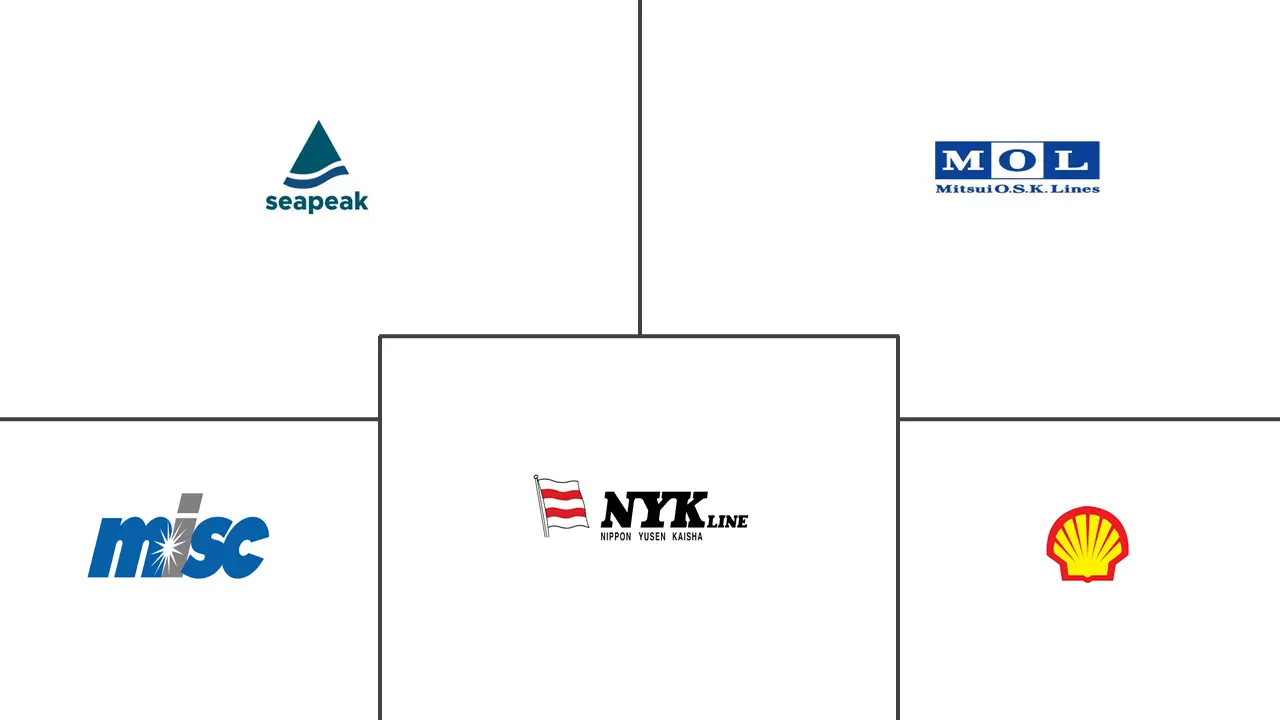LNG Carriers Market Size and Share
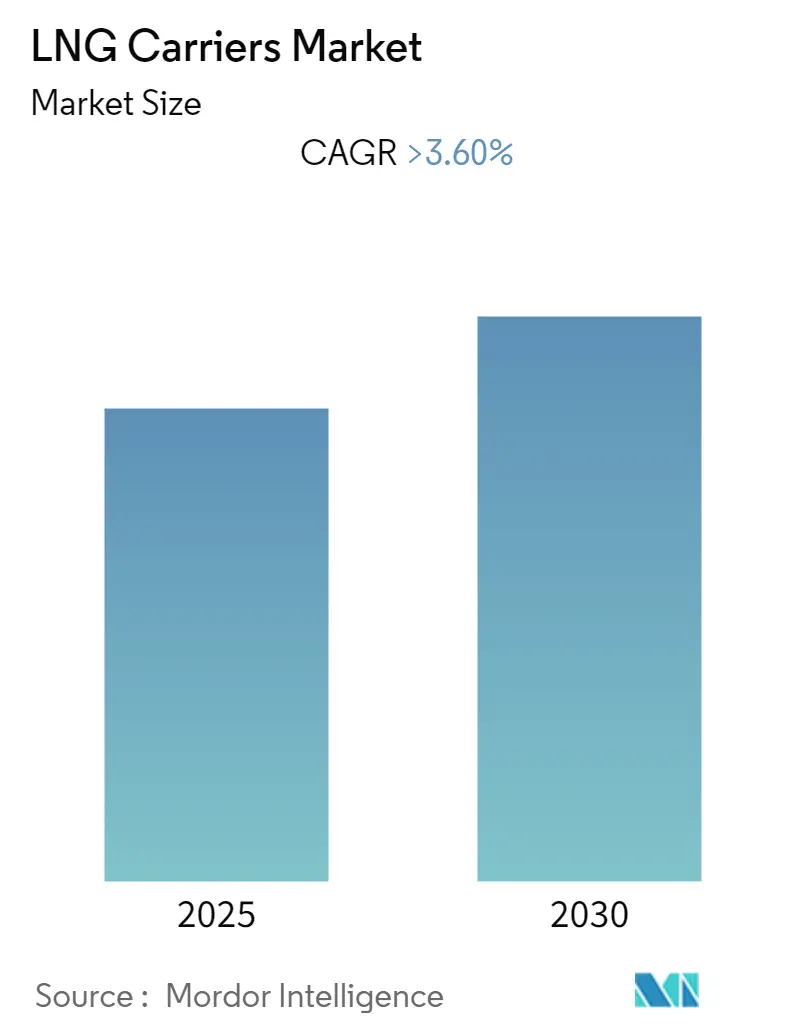
LNG Carriers Market Analysis by Mordor Intelligence
The LNG Carriers Market is expected to register a CAGR of greater than 3.6% during the forecast period.
COVID-19 moderately impacted the market in 2020. Currently. The market has reached pre-pandemic levels.
- Over the medium period, factors such as flexible deployment capabilities, increased efficiency, and increasing global consumption of LNG driven by supportive government regulations and demand from several end-user industries, including power generation and industrial, are expected to drive the market in the coming years.
- On the other hand, with the new carrier fleet entering the market and with regional shipping imbalances, carriers' charter rates have fluctuated, which may hinder the market's growth during the forecast period.
- Nevertheless, many terminals are adjusting to accommodate small-scale and bunkering vessels to comply with emissions targets and capture new commercial opportunities. Conventional oil-based fuels will remain the main fuel option for most vessels in the future. At the same time, commercial opportunities of LNG are interesting.
Global LNG Carriers Market Trends and Insights
Membrane-Type Containment to Dominate the Market
- The membrane-type segment held the largest market share owing to its higher carrying capacity and other advantages. This containment segment is expected to dominate the global market throughout the forecast period.
- Gaztransport and Technigaz (GTT) designed the most common membrane tank systems. Several GTT systems have already been implemented onboard LNG carriers for many years, and other designs from different companies have been developed.
- Moreover, in December 2022, Samsung Heavy Industries (Shi) awarded Gaztransport & Technigaz (GTT) two contracts for the tank design of seven new LNG carrier vessels. The contracts were awarded on behalf of both a European and an American shipowner. Each LNG vessel will be 174,000m3 in size. The vessels are expected to be delivered in the first and fourth quarters of 2026 and 2027.
- By 2021, 518 units of the active fleet had a GTT membrane-type containment system which accounted for 81% of the current fleet count. It continued to lead the order book as the preferred containment option.
- Due to technological advancements, membrane-type containment has a superior capacity to bear the immense pressure of LNG and its compact shape to carry large LNG volumes compared to moss-type containment.
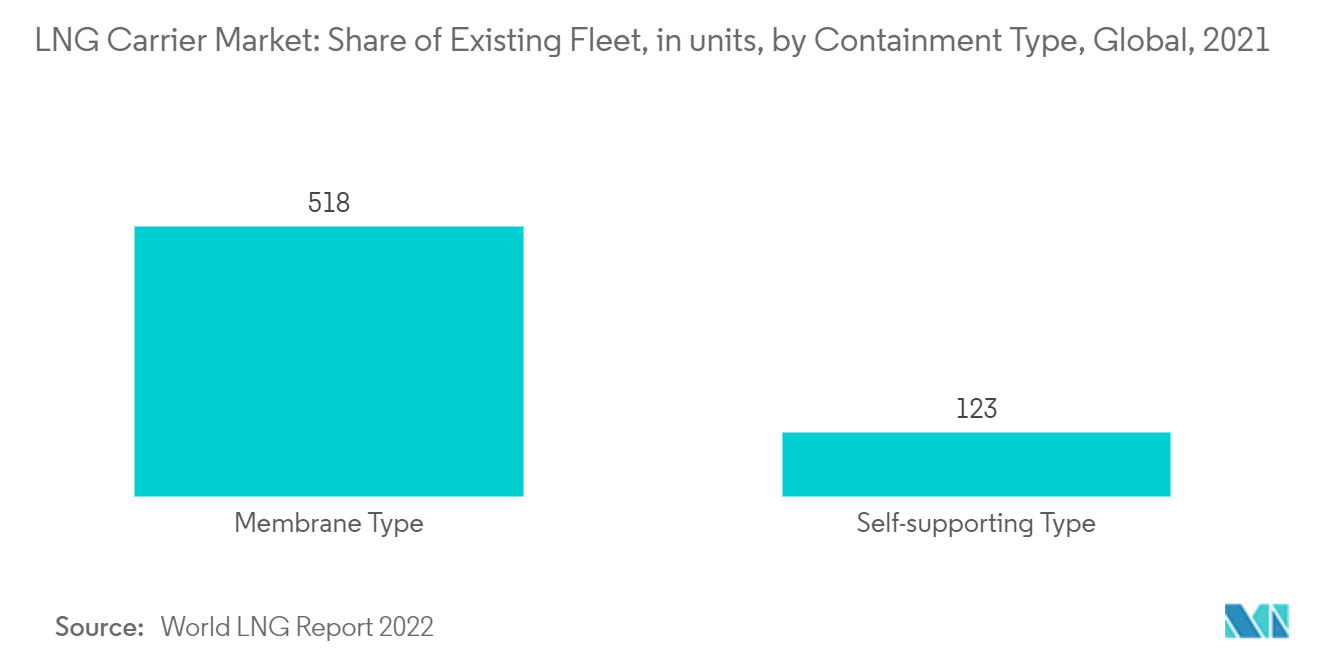
Asia-Pacific to Dominate the Market
- The Asia-Pacific accounted for the largest LNG carrier market share due to increased demand for natural gas because of high industrial growth and the adoption of clean energy sources. Therefore, the region is expected to continue its dominance in the market throughout the forecast period. Most of the demand in the region came from China.
- Meanwhile, China has accelerated its policy of reducing emissions and pollution through coal-to-gas conversion, increasing its LNG consumption by 15.0%. Several other Asian countries and regions, notably South Korea and Chinese Taipei, will dramatically expand LNG imports in 2021. As of 2021, Asia Pacific accounts for 72% share of total global LNG imports
- China imported 109.5 billion cubic meters of liquefied natural gas (LNG) in 2021, an 16.8% increase compared to 2021. Therefore, China became a vital contributor to the global LNG industry's development and prosperity. Net LNG imports in Asia Pacific in 2021 increased by 7.3%.
- The growing LNG consumption by various end-user industries, such as manufacturing, petrochemicals, and fertilizers, is on a consistent rise in China and South Korea. Japan prevalently consumes LNG for power generation. These countries are expected to aid in the growth of the Asia-Pacific market.
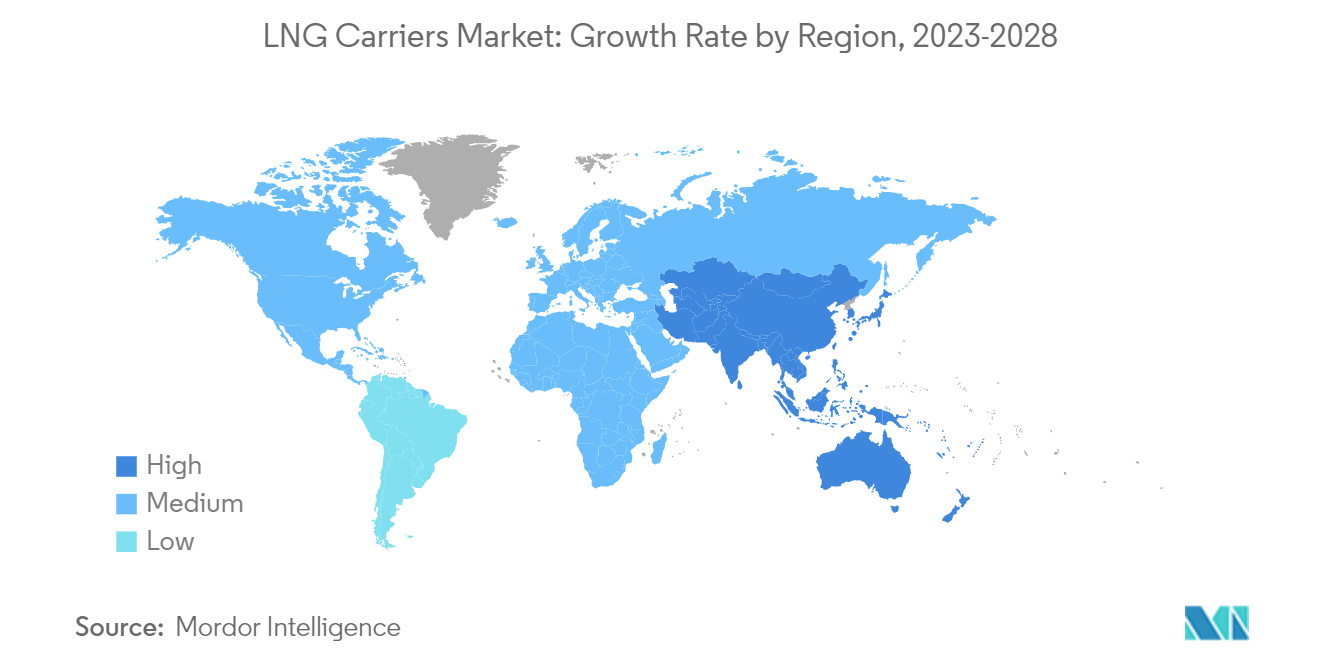
Competitive Landscape
The LNG carrier market is moderately fragmented. A few major companies operating in the market (not in a particular order) include Royal Dutch Shell PLC, Nippon Yusen Kabushiki Kaisha, Mitsui OSK Lines Ltd, MISC Berhad, and Seapeak, among others.
LNG Carriers Industry Leaders
-
Royal Dutch Shell PLC
-
Nippon Yusen Kabushiki Kaisha
-
MISC Berhad
-
Mitsui O.S.K. Lines Ltd
-
Seapeak
- *Disclaimer: Major Players sorted in no particular order
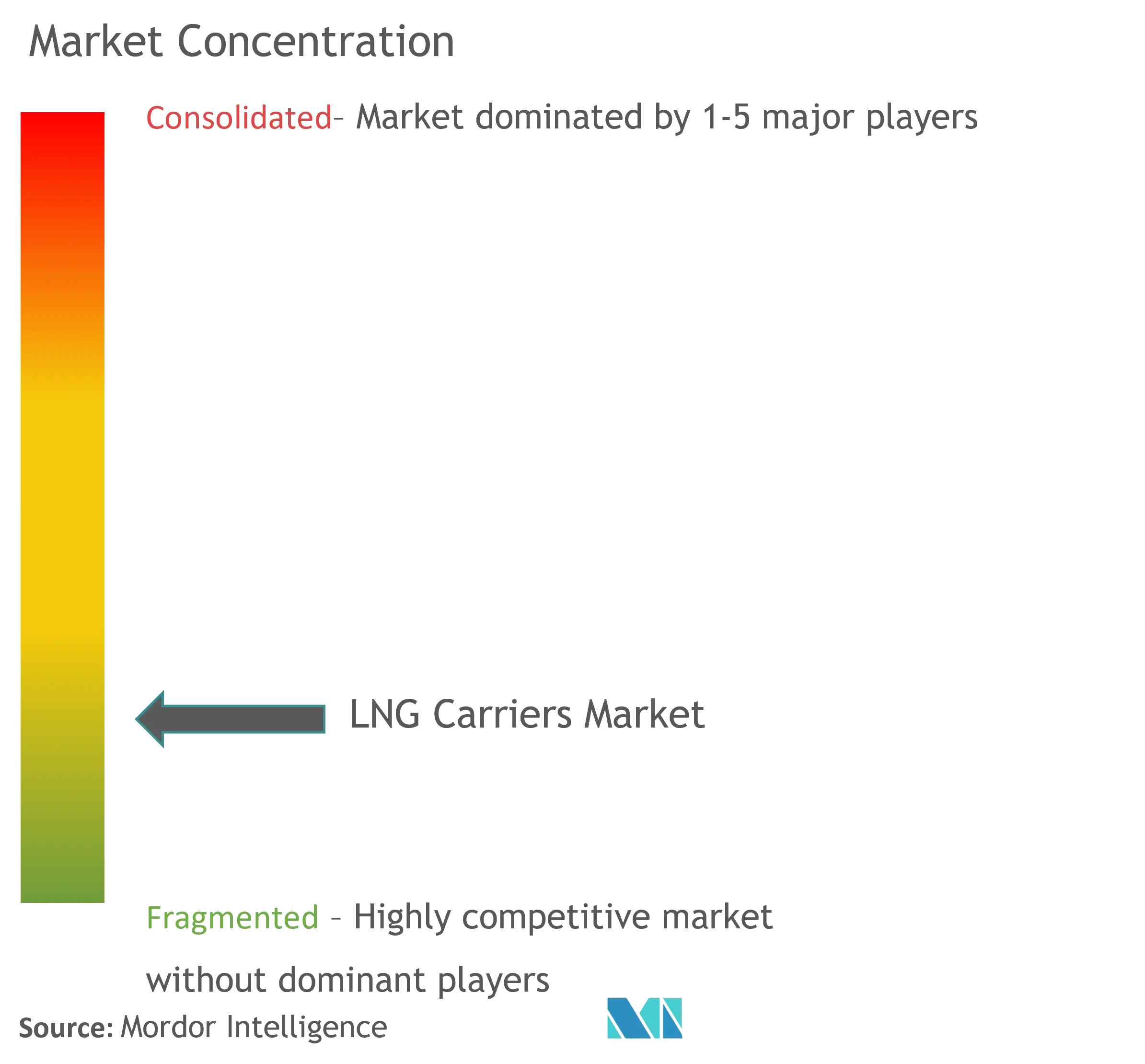
Recent Industry Developments
- December 2022: GAIL (India) Ltd agreed to time charter a new liquefied natural gas (LNG) carrier with Japan's Mitsui O. S. K. Lines Ltd (MOL) and acquired a stake in an existing LNG carrier. The new LNG carrier, built by South Korea's Daewoo Shipbuilding & Marine Engineering Co Ltd, will be the second MOL Group LNG ship to serve GAIL and will commence time chartering in 2023.
- October 2022: GTT announced that it earned two Approvals in Principle (AiP) from DNV and Bureau Veritas for its revolutionary three-tank LNG tanker design (BV). The three-tank LNG carrier concept reduces construction costs by eliminating one cofferdam, one pump tower, and all related cryogenic equipment (liquid and gas domes, valves, piping, radars, etc.).
Global LNG Carriers Market Report Scope
An LNG carrier is a ship designed to transport liquefied natural gas in its chilled tanks. LNG carriers emit fewer greenhouse gases than conventional vessels because they are powered by natural gas.
The LNG Carrier market is segmented by containment type, propulsion type, and geography. By containment type, the market is segmented into membrane type and moss type. By propulsion type, the market is segmented into steam turbines, dual-fuel diesel engine/tri-fuel diesel engines (DFDE/TFDE), slow-speed diesel (SSD), M-type electronically controlled gas injection (ME-GI), XDF two-stroke engine, and steam re-heat and stage. The report also covers the market size and forecasts for the LNG carrier market across the major regions (North America, Europe, Asia-Pacific, Middle-East and Africa, and South America). For each segment, the market sizing and forecasts have been done on the revenue (USD billion).
| Moss |
| Membrane |
| Steam Turbines |
| Dual Fuel Diesel Engine/Tri-Fuel Diesel Engine (DFDE/TFDE) |
| Slow-Speed Diesel (SSD) |
| M-type Electronically Controlled Gas Injection (ME-GI) |
| XDF Two-stroke Engine |
| Steam Re-heat and Stage |
| North America | United States |
| Canada | |
| Rest of the North America | |
| Asia-Pacific | China |
| India | |
| Japan | |
| South Korea | |
| Rest of the Asia-Pacific | |
| Europe | Germany |
| France | |
| Spain | |
| United Kingdom | |
| Rest of the Europe | |
| South America | Brazil |
| Argentina | |
| Rest of the South America | |
| Middle-East and Africa | United Arab Emirates |
| Nigeria | |
| Saudi Arabia | |
| Rest of the Middle-East and Africa |
| Containment Type | Moss | |
| Membrane | ||
| Propulsion Type | Steam Turbines | |
| Dual Fuel Diesel Engine/Tri-Fuel Diesel Engine (DFDE/TFDE) | ||
| Slow-Speed Diesel (SSD) | ||
| M-type Electronically Controlled Gas Injection (ME-GI) | ||
| XDF Two-stroke Engine | ||
| Steam Re-heat and Stage | ||
| Geography [Market Size and Demand Forecast till 2028 (for regions only)] | North America | United States |
| Canada | ||
| Rest of the North America | ||
| Asia-Pacific | China | |
| India | ||
| Japan | ||
| South Korea | ||
| Rest of the Asia-Pacific | ||
| Europe | Germany | |
| France | ||
| Spain | ||
| United Kingdom | ||
| Rest of the Europe | ||
| South America | Brazil | |
| Argentina | ||
| Rest of the South America | ||
| Middle-East and Africa | United Arab Emirates | |
| Nigeria | ||
| Saudi Arabia | ||
| Rest of the Middle-East and Africa | ||
Key Questions Answered in the Report
What is the current LNG Carriers Market size?
The LNG Carriers Market is projected to register a CAGR of greater than 3.6% during the forecast period (2025-2030)
Who are the key players in LNG Carriers Market?
Royal Dutch Shell PLC, Nippon Yusen Kabushiki Kaisha, MISC Berhad, Mitsui O.S.K. Lines Ltd and Seapeak are the major companies operating in the LNG Carriers Market.
Which is the fastest growing region in LNG Carriers Market?
Europe is estimated to grow at the highest CAGR over the forecast period (2025-2030).
Which region has the biggest share in LNG Carriers Market?
In 2025, the Asia Pacific accounts for the largest market share in LNG Carriers Market.
What years does this LNG Carriers Market cover?
The report covers the LNG Carriers Market historical market size for years: 2019, 2020, 2021, 2022, 2023 and 2024. The report also forecasts the LNG Carriers Market size for years: 2025, 2026, 2027, 2028, 2029 and 2030.
Page last updated on:
LNG Carriers Market Report
The global liquefied natural gas (LNG) carrier market is experiencing significant growth driven by the increasing demand for natural gas across industrial, commercial, and residential sectors, particularly in developing economies. The market outlook indicates that LNG carriers are becoming essential due to the growing emphasis on clean energy and stringent emission regulations. The market analysis reveals that the LNG carriers market is segmented by containment type, storage capacity, propulsion type, and end-user industry. Membrane-type containment systems and large storage capacities are leading the market due to their efficiency and cost-effectiveness.
The industry analysis highlights the various propulsion types, including steam turbines, dual-fuel diesel engines, and slow-speed diesel engines, among others, catering to various operational needs. The market share of LNG carriers is primarily driven by the transport and defense sectors, with a notable rise in international transportation. Despite challenges such as high manufacturing costs and fluctuating charter rates, the market forecast suggests substantial growth, supported by technological advancements and increasing LNG trade.
Industry reports and market research indicate that LNG carrier companies are continually innovating to meet the rising demand and regulatory requirements, ensuring robust market expansion. The market value and market trends point to a positive industry outlook, with significant growth in industry size and market segmentation. The market review and market predictions further emphasize the importance of LNG carriers in the global market.
Industry information and market data provide comprehensive insights into the industry's growth rate and market growth. The industry statistics and market overview offer a detailed understanding of the market dynamics. The industry sales and market leaders are crucial in driving the market forward, with industry research playing a vital role in shaping the future of LNG carriers.
Overall, the report pdf and report example serve as valuable resources for understanding the LNG carrier market. Research companies and industry stakeholders can leverage this information to make informed decisions and capitalize on the opportunities within the market. The market forecast and industry trends underscore the potential for significant growth in the coming years, driven by the increasing demand for natural gas and advancements in LNG carrier technology.
